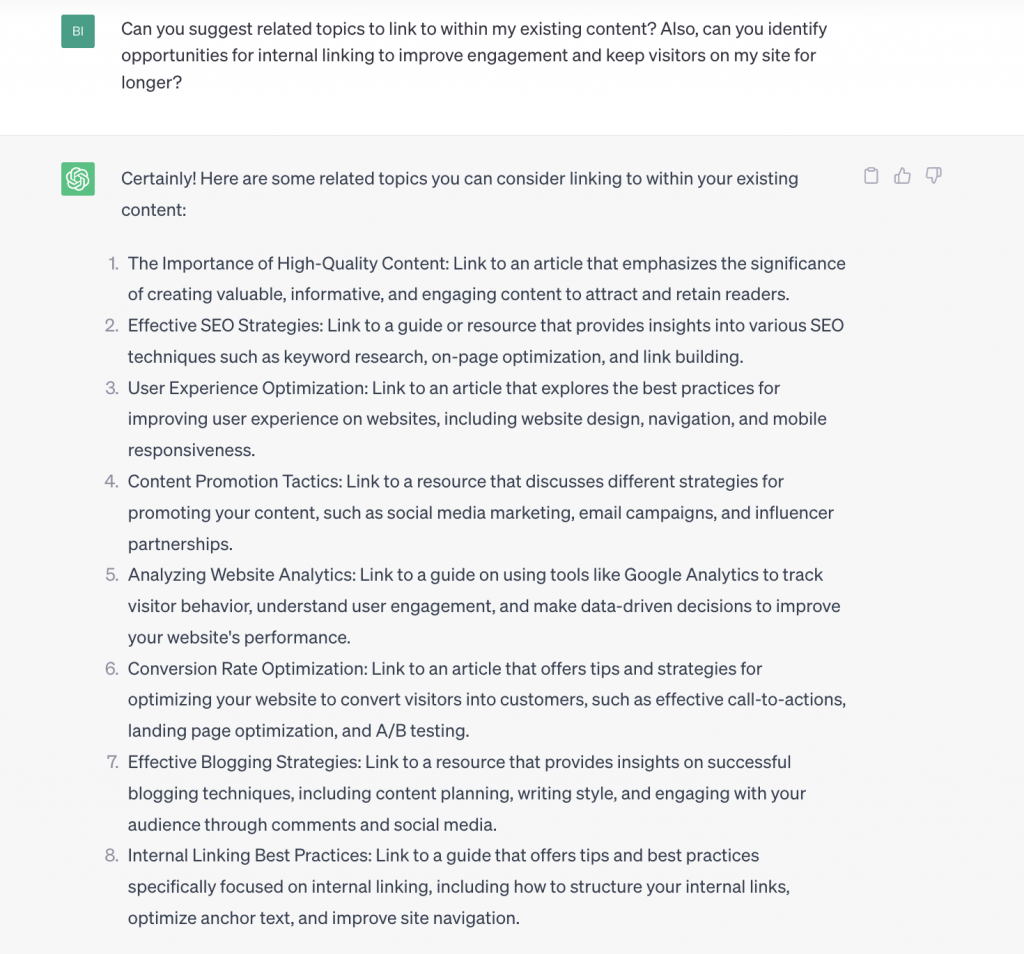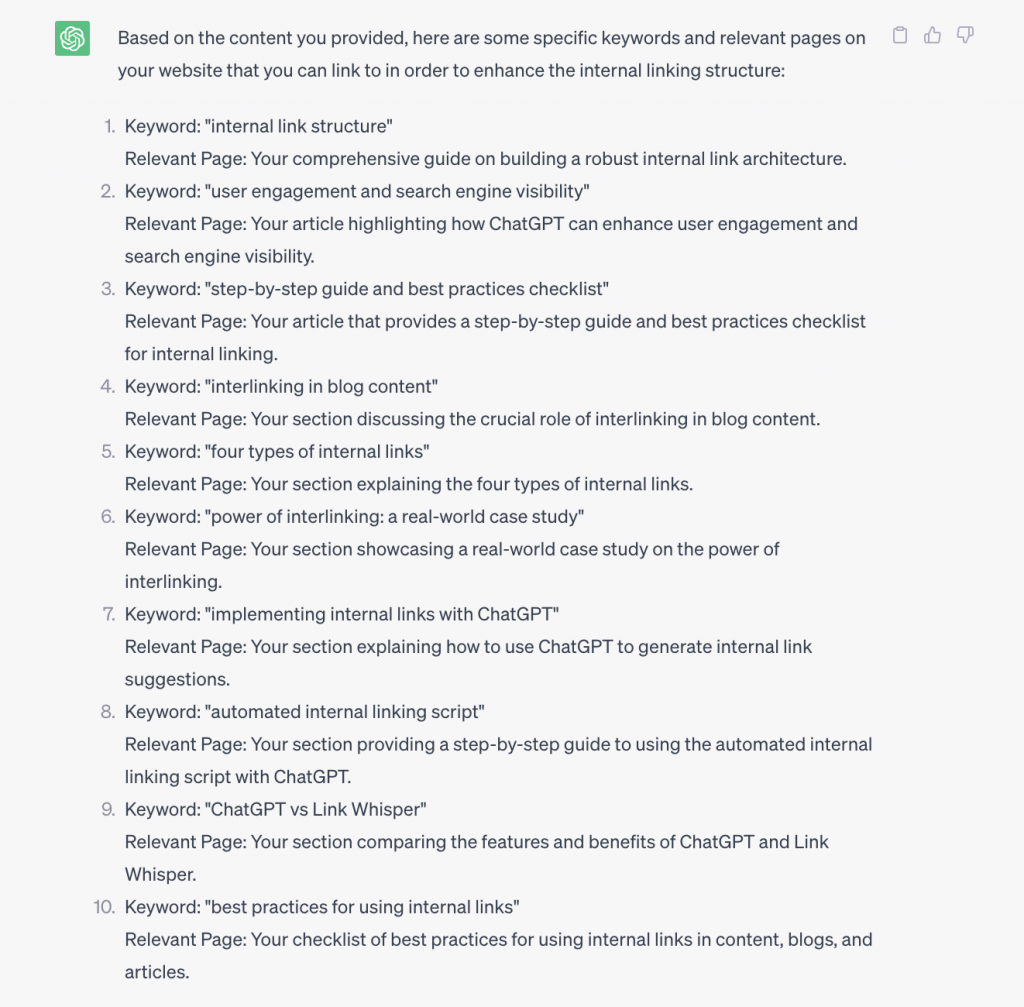Article at-a-glance: - A strong internal link structure enhances the user experience, guides readers through related articles, increases engagement, and sends positive signals to search engines. - Internal linking is an important aspect of website optimization that can help to channel authority and relevancy to certain pages. - By streamlining internal links in your content, ChatGPT can enhance user engagement and search engine visibility. - Using ChatGPT's versatile roles - from Idea Generator to SEO Metric Analyst, you can improve your site's performance and navigation. - Our step-by-step guide and best practices checklist will help you speed up your interlinking process, ultimately boosting your site's ranking.
With this comprehensive guide, we will show you exactly how to pepper your work with internal links. We will use ChatGPT to its full potential to make your content more effective, skyrocket user engagement, boost search engine visibility, and ultimately increase results.
Using this guide, you will be able to build a robust internal link architecture, regardless of whether you’re a seasoned creator or a rookie.
You’ll see a real-life example, get hands-on tips, and learn the secret sauce to using ChatGPT to enhance your blog’s performance and drive tangible results.
The Crucial Role of Interlinking in Blog Content
It’s important to remember:
Building a strong internal link architecture is essential. This ensures that your vital content is easily discoverable.
Imagine your site’s content as a spider web, interlinking weaves the strands, connecting the dots, providing a seamless navigation experience for your visitors and helping them discover more gems from your content vault.
The benefits of interlinking are many.
On the one hand, it improves the overall user experience, guiding readers through related articles, unveiling relevant topics, and peeling back layers of your content. Internal linking allows you to spread the ranking power and authority across your website.
This increases your readers’ engagement and glues them to your site, sending positive signals to search engines.

What Are The 4 Types of Internal Links?
The internal links of your website are like secret passages that assist you in getting around your website, which is like a big house with many rooms.

There are four kinds of secret passages:
- Navigation Links: These are like your main hallways. They help you find your way around your house, discover what’s inside each room, and navigate your way around your house.
- Contextual Links: These are like hidden doors in your walls. Your website contains them right in the stories. They lead you to different rooms where you can read more exciting tales and learn fun things about the topic. Contextual material surrounds these links, helping search engines understand the context of the link. Search engines value contextual links more than standalone links because they are more relevant to the content and provide more information about a website’s structure. In this guide, we will show you how to build this type of internal links with the help of ChatGPT.
- Footer Links: These are like basement doors. Your website has them at the bottom. In addition to allowing you to wander around your house, they assist the search engine robots in figuring out how your house is constructed.
- Anchor Links: Imagine these as secret slides that take you straight to a specific spot in a room. When there’s a lot to see in a big room, they help you zoom right into what you want to see.
Remember these secret passages the next time you’re on your website – they’re there to make your visitors and you happy!
The Power of Interlinking: A Real-World Case Study
To better grasp the impact of interlinking, let’s get real with a real-world case study.
Consider Spencer Haws, the creator of nichepursuits.com, who successfully boosted page rankings using strategic interlinking. During his three-month experiment, he sprinkled 108 links across 47 orphaned pages.

The results were stunning – 76.6% of these posts increased their ranking in Google, while 14.9% held their ground, and a mere 8.5% dipped slightly.
Several stars even reached the coveted 1st position on Google.
The tool behind this magic was Link Whisper: Spencer used Link Whisper to add 2-3 links per page (at most nine), speeding up the interlinking process.
His orphaned pages became traffic magnets. Organic traffic increased. What’s more, old articles started receiving more attention from Google. There is no doubt that Google’s algorithm and ranking factors are geared toward valuing content that is relevant and has stood the test of time.
As you can see, your website’s ranking potential can be enhanced by strategically implementing internal linking. This involves connecting important pages with relevant counterparts, distributing link equity effectively, and giving those pages a boost in search engine results.
You will increase your website’s visibility and credibility in search engine results by intentionally interlinking your pages with one another.
When a website plays the interlinking card right, we can expect the following results:
- the bounce rate decreases significantly, proving that visitors stay longer and explore multiple pages;
- the average session duration increases indicating that users hit the jackpot with valuable content via internal links;
- search engine rankings soar for targeted keywords: by guiding search engine crawlers through the internal link structure, relevant pages get indexed and featured in search results, boosting organic traffic.
Interlinking is more than just a search engine optimization technique. It engages users, guides them on a content journey, and signals to Google that your site is a treasure trove worth exploring.
Internal links guide search engine crawlers to relevant pages, resulting in your website appearing in search engines and driving organic traffic.
ChatGPT is an essential tool for SEO content writers. It can give you more time, simplify your process, and improve your content quality for both search engines and readers.
I. How To Get Internal Links With ChatGPT
Optimising your website’s internal linking structure is crucial to improving user experience and search engine rankings. Thanks to ChatGPT’s advanced capabilities, you can use its internal link prompts to uncover valuable internal linking opportunities. Here’s how it works:
Using its analytical abilities, ChatGPT analyzes your website’s content to identify the most relevant keywords and phrases that align with your overall message.
Plugins by OpenAI connect ChatGPT to the internet. They allow ChatGPT to browse the internet and draw data from around the web to answer questions posed to it.
Alternatively, you can feed in ChatGPT with information about your published content, including titles and URLs of pages.

1. Link Suggestions
Based on the identified keywords and phrases found in your content, ChatGPT suggests relevant pages within your website to link to. The suggestions include both optimizing existing pages and creating new pages to enhance internal linking.
Analyze the content on my website and provide link suggestions based on identified main keywords and phrases found in the content. Suggest relevant pages within the website to link to, aiming to optimize existing pages and create new pages for enhancing internal linking.

2. Keyword Relevance
ChatGPT ensures that the suggested pages are relevant to the keywords and phrases found within your content to enhance both user experience and SEO. By meticulously focusing on keyword relevance, your website can drive organic traffic and reinforce its authority.
Based on the keywords and phrases you identified within my content, can you suggest specific keywords and relevant pages on my website that I can link to in order to enhance the internal linking structure? I want to ensure that the internal links are keyword-relevant and effective for both user experience and SEO.

3. Anchor Text Suggestions
With ChatGPT, you’re not just getting page recommendations, you’re getting all kinds of compelling anchor text options. With precision-crafted anchor text, your internal links gain more effectiveness and relevance.
Can you provide me with some compelling anchor text options to make my internal links more effective and relevant

4. Article Creation with Existing Links
You can even ask ChatGPT to write an article based on the existing links on your site and then add these links as internal links within the article.
To do this, you must use ChatGPT’s Advanced Data Analysis feature (previously known as Code Interpreter). Get the list of your site URLs from the sitemap and upload it in the form of a TXT file to ChatGPT (new conversation). In that conversation, ask ChatGPT to create an article by including at least 5 to 10 internal links.
After you’ve gathered valuable insight from ChatGPT’s internal link prompts, it’s time to bring these links to life. In turn, you’ll improve user experience, search engine optimization, and ultimately, your online success.
You can revamp your website’s internal linking structure with ChatGPT’s internal link prompts. By identifying relevant pages to link to with ChatGPT, you can enhance the efficacy and relatability of your internal links. You’ll get more traffic and better search rankings.
II. ChatGPT Script for Automated Internal Linking: Fast-Track Your Interlinking with This Easy Process
Get ready for a game-changer! The video below explains how a script written by ChatGPT will boost your web pages’ rankings and save you time.
This video walks you through the traditional method of building internal links, then dives into the big one: an automated script that can be used with Google Docs.
The result? Improved rankings and visibility with less effort. With this script, you’ll start winning with rankings and traffic right away.
Here’s the short version: it’s all about leveraging internal links for maximum organic search power.
Here’s the step-by-step guide to make it happen:
- Make a copy of this Google Doc. This is your interlinking sandbox.
- Copy and paste the article you want to create internal links for into the doc. Clear out any existing content except your article.
- Create a Google Sheet with two columns: column A for keywords, column B for corresponding links. Use a tool like Ahrefs or Google Search Console to export relevant links for each keyword.
- Copy the ID from the Google Sheet’s URL. It’s the text between “d/” and “/edit” in the document URL.
- Jump back to your Google Doc. Head to the menu, select “Extensions,” and then click “Apps Scripts.”
- Replace the text on the line in the script editor saying “this is the id of the sheet with your keywords” with your copied ID of your Google Sheet.. Click “Save” and “Run.”
- Give the script the permissions it needs to work on your projects.
- The script adds internal links into your article automatically, enhancing navigation and connecting readers to related content.
- If your article’s already live on your blog, remember to update it with the suggested interlinks. Your entire website will benefit from a robust internal link structure if you follow this step.
In a matter of seconds, you’ve supercharged your blog interlinking. It’s that simple
ChatGPT vs Link Whisper
Link Whisper and ChatGPT are two tools that can improve your internal linking structure.
As we saw in the previous example, ChatGPT can generate content and suggest relevant pages on your website to link to based on the keywords and phrases in your content. It can also suggest anchor text for internal links.
Link Whisper, on the other hand, is a WordPress plugin that uses its own internal algorithm to recommend internal links for optimization.

It uses its own internal algorithm to suggest internal links. It suggests relevant internal links when you start writing your article right within the WordPress editor and helps you quickly see which pages have very little or no internal links pointing to them.
By highlighting pages with minimal internal links, it provides a quick and easy way to make them more visible. It’s super easy to bring new life to forgotten articles by adding fresh internal links and optimizing them.
Even with the free version of Link Whisper plugin, you can open a world of endless possibilities for your website’s optimization, growth and success.

The following table provides a comparison of ChatGPT and Link Whisper. By comparing these tools side by side, you can make an informed decision on which tool best suits your needs for enhancing internal linking and improving SEO performance.
| Feature | ChatGPT | LinkWhisper |
|---|---|---|
| Function | ChatGPT is a language model developed by OpenAI that can help with content creation, keyword research, and SEO optimization. | LinkWhisper is a WordPress plugin that helps to streamline internal linking and improve the user experience on your website. |
| Keyword Research | ChatGPT can help to generate popular keywords and suggest related topics to link to within your existing content. | LinkWhisper can help to identify opportunities for internal linking and suggest relevant anchor text for your links. |
| Content Optimization | ChatGPT can suggest related topics to link to within your existing content and identify opportunities for internal linking to improve engagement and keep visitors on your site for longer. | LinkWhisper can help to streamline internal linking and ensure that your links are relevant and useful to your readers. |
| Ease of Use | ChatGPT can be used through a variety of prompts and interfaces, including chatbots and AI assistants. | LinkWhisper can be easily installed and configured on your website. |
| Cost | ChatGPT is a paid service, with pricing plans based on usage and features. | LinkWhisper is a paid plugin, with pricing plans based on the number of websites and features. |
| Integration | ChatGPT can be integrated with a variety of tools and platforms, including WordPress, Google Sheets, and Zapier. | LinkWhisper integrates seamlessly with your website’s existing content and structure. |
Here is a video review of Link Whisper by Authority Hackers which explains the value of the tool and how it automatically suggests internal links for your content.
10 Best Practices for Using Internal Links in Content, Blogs & Articles: Checklist
Internal linking is all about keeping it natural and playing smart. Get your site ranked higher in search engines by following this checklist:
- Produce Quality Content – unique, valuable, and engaging: This is the bedrock of your site. It’s what attracts and retains your audience, and it’s what search engines love. You should always strive to produce unique, valuable, and engaging content that serves your audience’s needs.
- Choose Purposeful Anchor Text: An anchor text is the text that is clickable in a hyperlink. It is important to choose anchor text that provides context for the link. By doing so, you let readers and search engines know what they can expect from the linked page. You should avoid generic phrases like “click here” and instead use descriptive, relevant keywords.
- Include Links to Pages Deeper Within Your Website: Include links to pages deeper within your website rather than just the homepage or the main categories. The deeper your links are, the more likely the search engines are to discover and index lower-level pages on your site.
- Ensure Your Links Are Relevant & Seamlessly Integrated Into Your Content: Your readers may feel confused by forced or unnatural links, and search engines may flag them as manipulative. Use your internal links as an opportunity to build topical clusters and strengthen your site’s topical authority.
- Utilize Smart Follow Up Links: If you use follow links, search engines will follow the links and pass link equity to the linked page. If you don’t want search engines to follow links from untrusted content or paid links, use nofollow links but never internally. Many bloggers prefer for their internal links to open in a new tab.
- Include Keywords in Your Anchor Text: It’s not just about having descriptive anchor text. Put keywords in it to take it a step further. In this way, your linked page will tell the search engines what it is about.
- Direct Attention to High-Value & High-Converting Pages: No, we’re not just talking about your homepage or contact us page. Make sure your audience and search engines can find those pages that are high-value and high-converting.
- Avoid Using the Same Anchor Text for Different Pages: This one’s a no-brainer, but it’s worth repeating. Search engines and readers will be confused by it if you use duplicate anchor text.
- Utilize Google Search Console to Audit Your Links: Want to check how your internal links are doing? Google Search Console’s got you covered. Try it out and see where your internal linking needs to be tightened up.
- Place Important Links Higher Up on Your Page: Here’s the deal: links high up on your page carry more weight yet you don’t want to put them in your introduction of your article because this might increase your bounce rate. You don’t want to bury them deep within your content either. It’s important to place them where they can be easily found and give them the SEO credit they deserve.
Remember, you can use interlinking to help search engines see the magic links between your pages, too – it isn’t just a positive thing for your readers.
Is Your Site In Need of A Ranking & Visibility Boost ?
You can boost navigation, engagement, and search engine visibility with killer interlinking strategies and powerhouse tools like ChatGPT.
Why stop there?
Get your business ranked higher, gain authority, and increase online visibility with AmpiFire. To see the magic in action, make sure to check out our compelling case studies.
Content marketing is the key to harnessing your site’s full power.
Book an appointment with AmpiFire today!
Author
-
Head of Content Marketing & Branding at AmpiFire. Book a call with the team by clicking the link below.
Related Posts

How to Write Undetectable AI Content: A Step-by-Step Guide to Making Articles Sound Human
Master undetectable AI content creation with AmpiFire's proven strategies to humanize text and bypass detection tools effectively.

Starting an AI Content Marketing Business: Step-by-Step Guide
Launch your AI content marketing business successfully with our comprehensive step-by-step guide.

Does Google Hate AI Content? ChatGPT’s Stance on Detection, SEO, Indexing, & Duplicate Penalties
Learn how Google views AI Chat GPT content through the lens of Chat GPT. Discover the impact of indexing, duplicate…

BigCommerce’s One-Step Checkout Optimization Guide | Examples with SDK on GitHub
Boost conversions with optimized one-page checkout: Improve user experience, increase conversion rates, and reduce cart abandonment for your online store…

Contributed Articles: How to Get High Quality Exposure for Your Brand
Guest-contributed articles are extremely beneficial for your business as they provide a great source of high-quality exposure. This type of…

How To Write Engaging News Articles For Your Brand: 10 Tips To Spice Up Your Content And Make It Less Boring
No one wants to read a boring story. But if you want your brand to get noticed, it’s important that…










